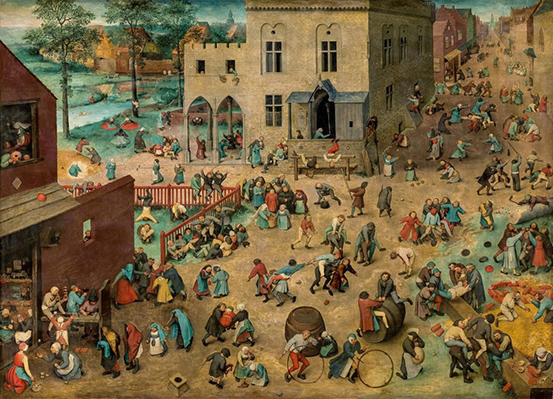CulBeat Express
2018.10.27 16:13
피터 브뤼겔 작고 450주년 회고전@비엔나미술사박물관(10/2-1/13, 2019)
조회 수 848 댓글 0
Bruegel
October 2, 2018–January 13, 2019.
Kunsthistorisches Museum Wien, Vienna, Austria

Pieter Bruegel the Elder, Children’s Games (1560), detail. Courtesy of KHM-Museumsverband
At the beginning of October, the Kunsthistorisches Museum will open the first-ever major monograph show dedicated to the
greatest Netherlandish painter of the sixteenth century: Pieter Bruegel the Elder (c. 1525/30‒1569). The exhibition
commemorates the 450th anniversary of his death.
During his lifetime, Pieter Bruegel the Elder was already among the period’s most sought-after artists, with his works achieving exceptionally high prices. Only about forty paintings and sixty prints by him are all that has come down to us. The twelve panels in the Kunsthistorisches Museum are by far the largest collection of Bruegels in the world, a fact we owe to 16th century Habsburg connoisseurs who already appreciated the exceptional quality of his works and strove to acquire these prestigious paintings.
Bruegel revolutionised landscape and genre painting, and his compositions continue to elicit varied and controversial
interpretations. The depth and breadth of his pictorial world and the perceptive powers of observation he employs in his depictions of quotidian life continue to fascinate a A once-in-a-lifetime exhibition Museums and private collectors count Bruegel’s works among their most precious and fragile possessions. Most of the panels have never been loaned for an exhibition. By bringing together over 90 works by the master, the exhibition in Vienna has assembled for the very first time a comprehensive overview of Bruegel’s oeuvre: comprising around 30 panel paintings (i.e. threequarters of extant paintings) and almost half of his preserved drawings and prints, the show offers visitors a once-in-a-lifetime opportunity to immerse themselves in the artist’s complex pictorial world, to study his stylistic development and his creative process, and to get to know his method of work, his pictorial humour and his unique narrative powers.
The highlights in the exhibition include, for example, The Haymaking from the Lobkowicz Collections, Prague, View of the
Bay of Naples from the Galleria Doria Pamphilij in Rome, Two Monkeys from the Staatliche Museen zu Berlin, The Triumph of Death from the Prado in Madrid, Dulle Griet from the Museum Mayer van de Berg in Antwerp, The Tower of Babel from the Museum Boijmans Van Beuningen in Rotterdam, The Adoration of the Magi in the Snow from the Collection Oskar Reinhard 'Am Römerholz' in Winterthur, The Adoration of the Magi from the National Gallery in London, the drawings The Beekeepers from the Staatliche Museen zu Berlin, and The Painter and the Connoisseur from the Albertina in Vienna.
Bruegel’s works will be arranged both chronologically and by theme, allowing visitors to study and appreciate his stylistic
development and the impressive variety of his oeuvre. The galleries will showcase both his masterpieces and series and
groups reunited for the first time in centuries; in the smaller adjoining rooms we present the findings of recent comprehensive technological analyses, offering profound insights into the works’ evolution. We look at both Bruegel’s artistic beginnings as a draughtsman and graphic artist, and his innovations and vital contributions to the evolution of landscape painting. One section of the show will focus on his religious works, bringing together numerous masterpieces including The Triumph of Death and Dulle Griet, both especially restored for this exhibition.
For the first time, Christ carrying the Cross, his largest panel and one that has also retained its original format, will be on show unframed and displayed so that both its back and front are visible – as though visitors were looking over the painter’s shoulder, seeing and appreciating the fragility of the wooden suppstudied the Brueghel dynasty, i.e. the works produced by the
master’s sons and his workshop, but our scientific focus is firmly on the founder of the dynasty and his creative process. We look at how his panels were constructed, at his brushwork and technique, at the history of materials and the works’ provenance.
Our research project is conceived as an essential component of the study and scholarly research of Bruegel’s oeuvre. Experts on Netherlandish painting meet regularly in Vienna to discuss the latest findings.
The extremely interesting findings of the technological analyses of the panel paintings document and reveal the master’s creative process. X-ray and infrared images, pigment analyses and 3Dphotographs of the paintings were produced in the Paintings Conservation Studio of the Kunsthistorisches Museum. These analyses have, for example, revealed little-known drawings beneath the paint layer that have never been studied in depth. Our most recent findings have informed both the exhibition and the catalogue. The technical studies funded by the Getty also help us understand how the wooden supports used by Bruegel have changed over time. This will inform the care of the paintings for the future, including conservation treatment. Even after the exhibition ends, a free website www.insidebruegel.net will for the first time offer profound insights into the paintings of Pieter Bruegel the Elder based on the most recent technological analyses of his works. Here visitors can interact with the master’s pictures using state-of-the-art technology, navigate the collection and study Bruegel’s complex pictorial world in unrivalled detail.






